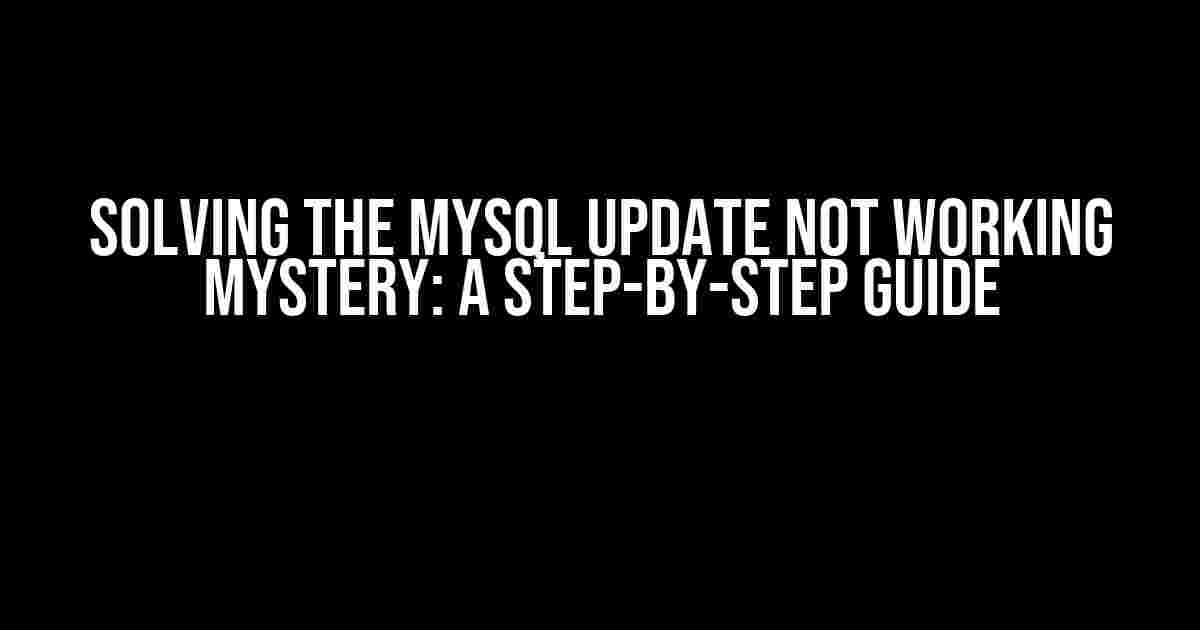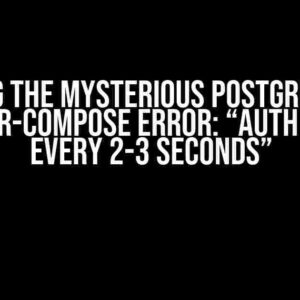If you’re stuck with a MySql update query that just won’t work, you’re not alone! In this article, we’ll delve into the common reasons why your MySql update statement might be failing, and provide a clear, step-by-step guide to troubleshoot and fix the issue. Specifically, we’ll focus on the query: Update lochave SET LCNT = 11 WHERE LSC = ''E'' and (LOCN1 >= 142 and LOCN2 <= 142).
The Anatomy of the Update Query
Before we dive into troubleshooting, let’s break down the structure of the update query:
Update lochave
SET LCNT = 11
WHERE LSC = ''E''
and (LOCN1 >= 142 and LOCN2 <= 142)This query aims to update the LCNT column in the lochave table to the value 11, where the conditions in the WHERE clause are met:
LSC = ''E'': The value in theLSCcolumn must be equal to'E'.(LOCN1 >= 142 and LOCN2 <= 142): The values in theLOCN1andLOCN2columns must fall within the specified range.
Common Reasons for Update Queries Not Working
There are several reasons why your MySql update query might not be working as expected. Let’s explore some common culprits:
1. Syntax Errors
A single syntax error can prevent the entire query from executing. Check for:
- Missing or incorrect punctuation (e.g., commas, quotes, parentheses)
- Typos in column or table names
- Inconsistent or incorrect use of case (e.g., uppercase vs. lowercase)
2. Incorrect Table or Column Names
Double-check that the table and column names match the actual database schema:
- Verify the spelling and case of table and column names
- Ensure the table and column names exist in the database
3. Permissions Issues
Make sure the user executing the query has the necessary privileges:
- Grant the user UPDATE privileges on the specific table
- Verify that the user has access to the database and table
4. Data Type Mismatch
Ensure that the data types of the columns match the values being updated:
- Verify the data type of the
LCNTcolumn (e.g., integer, string) - Check that the value
11is compatible with the column’s data type
5. Indexing Issues
Indexing can affect the performance and accuracy of the update query:
- Verify that the columns used in the
WHEREclause are indexed - Check for any indexing issues or conflicts
Troubleshooting Steps
Now that we’ve covered the common reasons for update queries not working, let’s walk through a step-by-step troubleshooting process:
- Check the query syntax: Verify that the query is free of syntax errors using a MySql client or IDE.
- Verify table and column names: Double-check the table and column names against the database schema.
- Check permissions: Ensure the user executing the query has the necessary privileges.
- Verify data types: Confirm that the data types of the columns match the values being updated.
- Check indexing: Verify that the columns used in the
WHEREclause are indexed. - Execute the query in parts: Break down the query into smaller parts to isolate the issue. For example, try executing the
SELECTstatement with the sameWHEREclause to see if it returns any results. - Check the MySql error logs: Review the MySql error logs for any errors or warnings related to the update query.
Optimizing the Update Query
Once you’ve identified and fixed the issue, let’s optimize the update query for better performance:
| Optimization Technique | Description |
|---|---|
| Indexing | Create indexes on the columns used in the WHERE clause (LSC, LOCN1, and LOCN2) to improve query performance. |
| Query rewriting | Rewrite the query to use more efficient syntax or logic. For example, consider using a JOIN instead of a subquery. |
| Batch updates | Break down large updates into smaller batches to reduce the load on the database and improve performance. |
Conclusion
In this article, we’ve explored the common reasons why a MySql update query might not work as expected and provided a step-by-step guide to troubleshoot and fix the issue. By following these steps and optimizing the update query, you’ll be well on your way to resolving the mystery of the MySql update not working.
Remember to always:
- Verify the query syntax and table/column names
- Check permissions and data types
- Optimize the query for better performance
By following these best practices, you’ll be able to tackle even the most complex update queries with confidence!
Frequently Asked Question
Stuck with the MySQL update query? Don’t worry, we’ve got you covered!
Why is my MySQL update query not working?
Check for syntax errors and typos! Make sure the column names, table names, and conditional statements are correct and match your database schema. Also, verify that the MySQL user has the necessary permissions to update the table.
Is the locking mechanism causing the issue?
Yes, it could be! The `lockhave` table might be locked by another process or query, preventing your update query from executing. Try running the query with a `LOCK TABLES` statement or check if there are any other active transactions that might be holding a lock on the table.
What about the conditional statements in the WHERE clause?
Good point! The conditional statements in the WHERE clause, such as `LOCN1 >= 142 and LOCN2 <= 142`, might not be evaluating as expected. Verify that the data types and values match the conditions, and consider using parentheses to ensure the correct order of operations.
Could the issue be related to indexing or indexing type?
Possibly! If the columns used in the WHERE clause are not indexed, it could slow down the query or prevent it from updating correctly. Check if the columns `LSC`, `LOCN1`, and `LOCN2` have suitable indexes (e.g., BTREE or HASH) and consider adding them if necessary.
How can I troubleshoot and optimize the update query?
Use the EXPLAIN statement to analyze the query plan, and enable the query log to identify any errors or performance bottlenecks. You can also try breaking down the query into smaller parts, testing each condition separately, or using a SELECT statement with the same conditions to verify the results.




![Using PHP/PDO/MySQL: Records have started vanishing (literally) without changes to the code [closed] Using PHP/PDO/MySQL: Records have started vanishing (literally) without changes to the code [closed]](https://garlin.hkhazo.biz.id/wp-content/uploads/sites/758/2024/07/using-php-pdo-mysql-records-have-started-vanishing-literally-without-changes-to-the-code-closed-with-text-300x300.jpg)